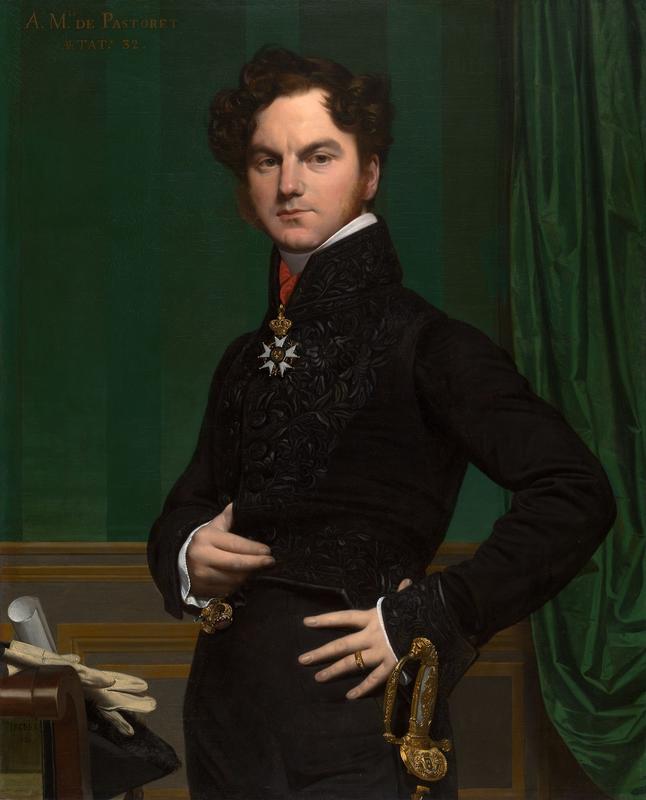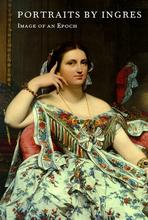More about Amédée-David, the Comte de Pastoret
- All
- Info
- Shop

Sr. Contributor
Amédée-David Pastoret could have tried to blame Ingres for how arrogant he looks in this painting, but it turns out he was just born that way.
In fact, his whole family was. Pastoret came from a long line of suck-ups and opportunists, and he had the artworks by Ingres to show it. Pastoret owned seven works by the Neoclassical master, including The Entry Into Paris of the Dauphin, the Future Charles V, which is currently at the Wadsworth Atheneum and boldly pledges his family’s allegiance to the French monarchy. Taking cues from his family, Pastoret played both sides when power bounced between Napoleon and the Bourbon royal family during the tumultuous time of nineteenth-century French politics. This allowed him to coast by and gain increasing political power over time.
In 1824, Pastoret received the Legion of Honor, the highest decoration in France established by Napoleon Bonaparte. First named a commander, Pastoret was promoted to grand officer in 1853 under Napoleon III. Pastoret’s good fortune was ultimately useful for Ingres, and this portrait encapsulates how the two men scratched each other’s backs. While Ingres wanted to join the ranks of the Academy artists, Pastoret needed a well-respected artist to paint his portrait. Ingres painted this in 1823, the same year that Pastoret helped him become a member of the Académie Des Beaux-Arts. To make Pastoret look extra important, Ingres made sure to pay special attention to the nobleman’s sword hilt and the medal of the Order of the Legion of Honor.
The greatest student of Jacques-Louis David, Ingres fancied himself a history painter, but portraits are really how he brought home the bacon. A talented portraitist, Ingres conveyed Pastoret just as his friends described him: pretentious, vain, and, ultimately, mediocre. When the portrait was first officially exhibited at the 1827 Salon, viewers ridiculed Ingres’s painting style, commenting that the subject of the portrait looked dead. In addition to his ghostly pallor, Pastoret’s self-importance shines. The hand-on-hip pose and serious expression seem to say "I am so much better than you, and my hair is so much larger."
In 1846, during a visit to Pastoret’s home where this portrait hung, a Monsieur Pommereux unknowingly criticized the painting in front of Ingres. Beyond just embarrassing the artist in front of one of his own paintings, an account of the incident was also published in the newspapers, which caused a fight that eventually escalated into a duel. Fortunately, King Louis-Philippe stopped the duel before it occurred.
Sources
- Consulate General of France in New Orleans. “Order of the Legion of Honor.” 27 February 2019. https://nouvelleorleans.consulfrance.org/Order-of-the-Legion-of-Honor#:…
- Davies, Penelope J.E., Frima Fox Hofrichter, Joseph Jacobs, Ann M. Roberts, and David L. Simon. Janson’s Basic History of Western Art. 8th edition. Upper Saddle River, NJ: Pearson Education, Inc., 2009.
- The Art Institute of Chicago. “Amedee-David, the Comte de Pastoret.” The Collection. https://www.artic.edu/artworks/111317/amedee-david-the-comte-de-pastoret. Accessed 10 November 2020.
- Tinterow, Gary, and Philip Conisbee. Portraits by Ingres: Image of an Epoch. New York: The Metropolitan Museum of Art, 1999. https://books.google.com/books?id=Ss99wqlznxAC&printsec=frontcover&hl=e…. Accessed 10 November 2020).
Featured Content
Here is what Wikipedia says about Portrait of Amédée de Pastoret

Amédée-David, the Comte de Pastoret (1823-1826) is a portrait by French painter Jean-Auguste-Dominique Ingres. The oil on canvas painting depicts Count Amédée-David de Pastoret at 32 years old, wearing a medal of the Order of the Legion of Honor.
The portrait shows Amédée-David de Pastoret, a conseiller d'État and member of the Académie des Beaux-Arts. He was a close relation of the painter and commissioned several works, such as his The Dauphin's Entry Into Paris. It was painted the same year as Ingres' portrait of Madame Marcotte de Sainte-Marie - both works were badly received, precipitating a six-year period in which the artist produced no paintings. His next portrait would be his 1832 Portrait of Monsieur Bertin.
Still in his collection on his death, it was inherited by his widow and then their daughter the Marquise de Rougé du Plessis-Bellière. In 1884 it appeared in a catalogue of the marquise's collection at Château de Moreuil (Somme). After her death it was sold in 1897 as lot 85 in sale 4 on 10 and 11 May, where it was bought by the galerie Durand-Ruel. It was then acquired for 8745 francs by Edgar Degas and on his death it was sold off in 1918 in Paris. Selling for 90,000 francs, it was bought by the banker and collector David David-Weill, who then sold it to the Wildenstein Gallery, who in turn sold it to the Art Institute of Chicago in 1971, where it now hangs.
Check out the full Wikipedia article about Portrait of Amédée de Pastoret














Is it just me or does he have a sortof Colin Firth thing going on?